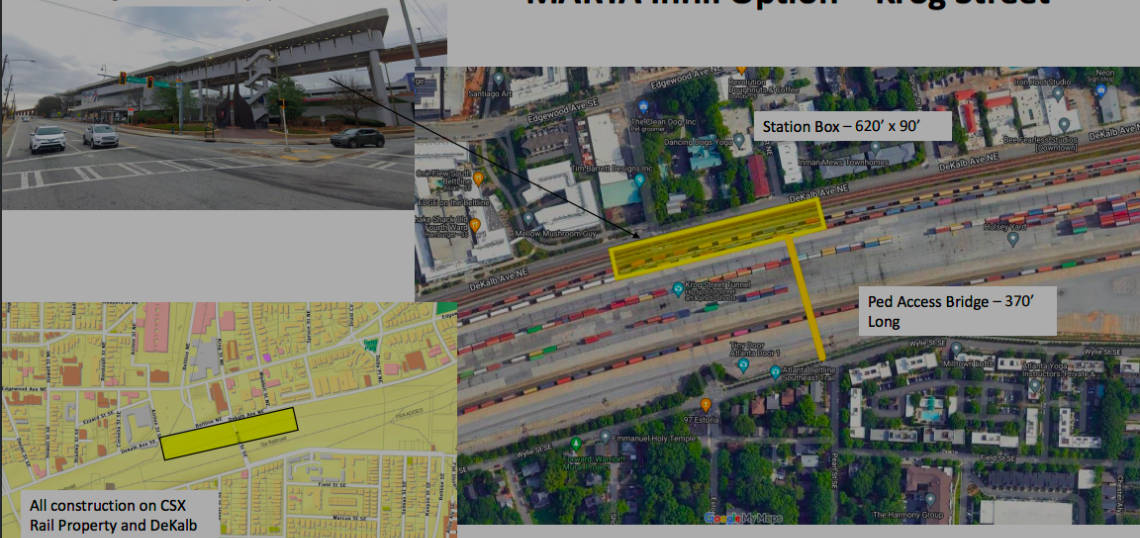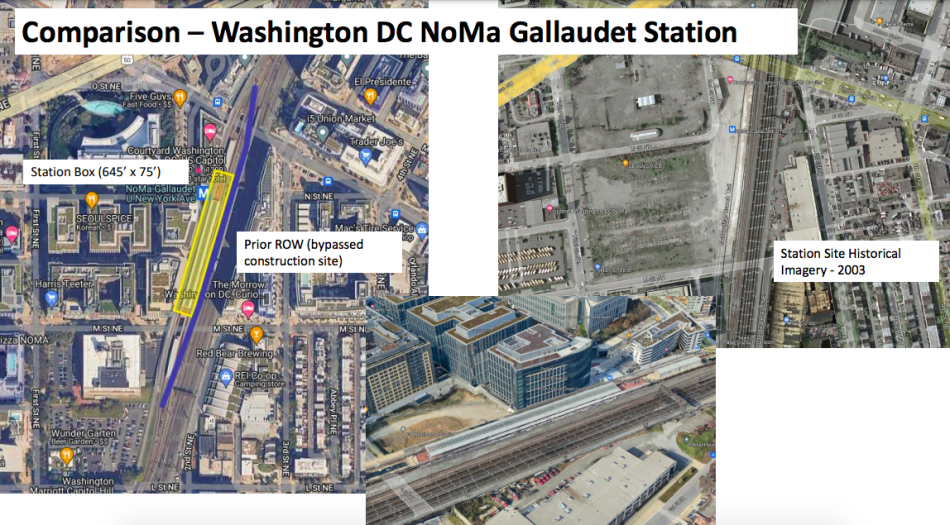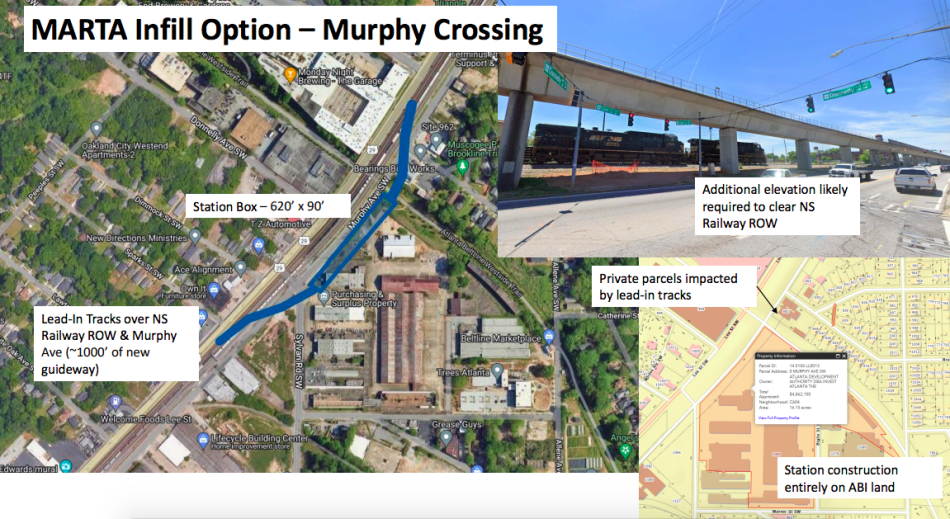Editor’s note: An aerospace engineer by day, Reynoldstown resident Kevin Butler describes himself as a frequent Atlanta BeltLine user and all-around transit enthusiast. Obviously. Frustrated with lack of details provided (so far) from the Mayor’s office and MARTA, Butler launched his own research pertaining to, in his estimation, the feasibility and cost of four proposed infill transit stations located along heavy rail lines near the BeltLine loop.
It’s admittedly an outsider’s perspective—but Grade A meaty food for thought. Note: The following letter has been lightly edited for clarity and length.
...
Dear Editor,
I’ve been pondering the latest distraction from BeltLine Rail, the city’s proposed (but unfunded and undesigned) four infill stations on MARTA heavy rail. These stations—at Krog Street, Murphy Crossing, Joseph E. Boone Boulevard, and Armour Yards—have been touted as cheap, quick, and easy improvements (relatively speaking) that can be done prior to, or as an alternative to, BeltLine Rail.
Those claims have been made without much substantiation—these plans are, again, unfunded and undesigned—so I decided to do some fact-checking myself.
First, let me say: I would love to see MARTA build infill stations. I think they’re a great idea, and should be built at some point in the future. However, what I want to show here is that they don’t need to be done first, and they won’t be easy or cheap. BeltLine Rail, in my opinion, remains a better and more cost-effective alternative.
MARTA did conduct a technical analysis of infill stations at all four of these locations during the 2016 More MARTA SPLOST initiative. None of the proposed infill stations were recommended for construction, due to high cost and low ridership impact.
Per MARTA’s own analysis, the cost to construct each station was roughly $103.5 million (Krog), $103.5 million (Murphy), $42.7 million (Boone), and $102.2 million (Armour) in 2016 dollars.
Collectively, that’s $351.9 million for all four proposed stations.
Doing some comparisons of my own, I believe these estimates to be quite low, but even using MARTA’s numbers, the cost of these four stations on existing right-of-way is equivalent to 6.4 miles of new-build BeltLine Rail. (That’s per MARTA’s own estimate of $55 million/mile for BeltLine LRT from the same study.)
Personally, I think the 6.4 miles of new connectivity is the much better deal.
But that’s all based on a very rough estimated cost, thrown together as part of a massive budget proposal. Let’s look at the costs and impact of building an actual heavy rail infill station, compared to other cities that have actually completed similar projects. (Disclaimer: I’m not a civil engineer or city planner; I’m an aerospace engineer by trade, so hopefully I’m not too far off base with my technical analysis).
A few heavy rail subway infill stations have been built in recent history. Comparable to the MARTA system I looked at: Boston’s Orange Line Assembly Station ($56 million in 2014 for a simple at-grade island platform station, entirely within existing right-of-way); Washington DC’s Potomac Yards Station ($370 million in 2023 for an at-grade station with elevated pedestrian infrastructure); and DC’s NoMa Gallaudet Station ($103.7 million in 2004 dollars—inflation adjusted to roughly $167 million today).
DC’s NoMa Gallaudet station seems like a good baseline comparison subject. It’s a relatively simple at-grade island platform station, built in an urban environment on vacant property, adjacent to heavy rail right-of-way. It also services the same modern high-capacity heavy rail transit vehicles as those used by MARTA.
Let’s call NoMa Gallaudet’s $167 million cost our baseline, and build from there.
- 1. Krog Street infill: This station location has two primary hurdles: station elevation, and real estate acquisition. The guideway at Krog is elevated roughly 60 feet above the street here; any station would be a towering behemoth similar to King Memorial down the street. Let’s double our baseline cost to start, just because everything will be on four-story stilts. Second issue is real estate. To the north there is no open land, to the south there’s CSX’s active freight rail line and Hulsey intermodal yard. All construction would need to weave itself around the active tracks and provide adequate clearance for intermodal operations (should CSX allow construction at all). An additional complication would be the fact that half of the station’s catchment is blocked by the CSX yard. Adding a pedestrian bridge could tack on an additional $50 million or more (as seen at WMATA’s recently opened Potomac Yards station, it too crossing CSX trackage). My estimate for Krog: $384 million. But hey, if CSX ever decides to give up its railyard real estate, Georgia Tech’s “MARTA Mountain” proposal sure would be cool.
- 2. Murphy Crossing infill: This location suffers the same elevation problem as Krog, but makes up for it with easy real estate. The entire station footprint could be built inside of Atlanta BeltLine Inc.’s own land at Murphy Crossing—just make sure it gets penciled in before the developers turn it into something else. This station could be built without much interruption to existing service. (It could be connected by new spur tracks, away from the existing right-of-way, compared to the construction nightmare Krog would pose with construction on top of existing rails). However, this station would also be a towering King Memorial-style elevated station, since the rails need to cross active Norfolk Southern right of way immediately before entering the station. I’ll give this one a relatively tame $200 million estimate.
- 3. Joseph E. Boone Boulevard infill: In this location I’m inclined to agree more with the MARTA estimate. Assuming a stubby two-car platform like Bankhead’s, this at-grade location (slightly trenched below grade) could be cheap and easy. Only major downside here would be private property acquisition. I’m counting four or five private residential lots and one multifamily property that would need to come down to build this station. Let’s round up to $50 million to fund the inevitable eminent domain lawsuits.
- 4. Armour Yards infill: This location isn’t too technically challenging, but looking at the catchment area around the station, I wonder why this one really needs to be built? I see two viable platform locations, both at-grade, one entirely on MARTA’s yard property (requiring some minor realignment of yard tracks), and one farther south that will impact three to four private parcels. Neither are particularly great for rider access. To the west, Norfolk Southern’s rail line blocks pedestrian access (even getting the BeltLine across here will be a massive ordeal; the train company has required several redesigns from ABI to get the trail across their tracks). To the north, Peachtree Creek, CSX rail, and MARTA’s own yard block the way. To the south, the imposing Interstate 85 and Buford Connector overpasses cut off the rest of the city. This station would truly only serve a small pocket of businesses, while most others in the area would be better served by going a half mile up the road to Lindbergh Center station. I’m not opposed to a station here—it just falls very low on my list of priorities. We’ll keep this one at the baseline estimate, $167 million.
I could go further and look at actual construction impacts. Building elevated infill stations along elevated guideway is unprecedented, and at best would require extended single-tracking (at worst long-term closure of the affected lines), but at this point, those details are hypothetical. If nothing else, these engineering constraints would simply result in higher overall cost.
So—all in, we’re looking at $801 million for four stations and no new guideway.
Compared to MARTA’s $55 million/mile for BeltLine Rail, that could buy us 14.5 miles (and all the associated station stops) of light rail; or put simply, 66 percent of the entire BeltLine light-rail loop. Done cleverly, BeltLine Rail could service every proposed infill location with a streetcar stop, add dozens of stops in between, and still maybe have a little money left over.
As a first step, that makes a lot more sense to me.
Disclaimer: Take this all with a massive grain of salt. These are rough estimates I made as a non-expert. If the City of Atlanta or MARTA can disclose more precise plans and details, I welcome them. Lacking any detail from the politicians, this is what I have come up with myself, as a transit-enthusiastic citizen who wants to see something—anything—get built.
...
Follow us on social media:
Twitter / Facebook/and now: Instagram
• Letter to Editor: Despite changes, Krog Street Tunnel traffic still screwed (Urbanize Atlanta)











